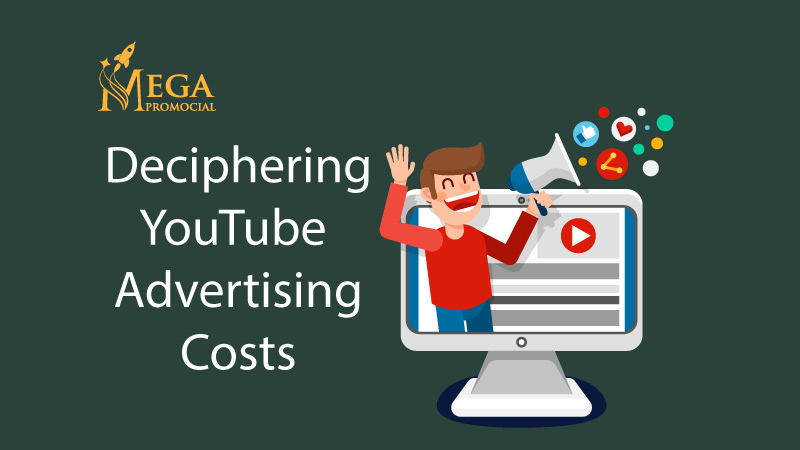Navigating the Future: Key Industry Trends Shaping Digital Marketing
In the fast-paced world of digital marketing, staying ahead of the curve is essential for businesses and marketer

Introduction
YouTube stands as a dominant force in the realm of advertising, boasting an unparalleled reach and a highly diverse audience. For those contemplating the realm of YouTube advertising, a profound understanding of the intricate factors shaping costs is imperative. This comprehensive guide is designed to unravel the layers of YouTube’s advertising landscape, providing insights into its structure, the pivotal influence of ad quality and relevance, the strategic role of targeting, the nuances of bidding strategies, and the dynamic variations in costs across the global landscape.

The foundation of YouTube’s advertising structure lies in its diverse ad formats, catering to the varied preferences of its massive user base. From skippable and non-skippable video ads to display ads, overlay ads, and sponsored cards, advertisers navigate a versatile landscape to engage their audience effectively. Understanding these formats is essential, as they intricately interplay with targeting options and bidding strategies, shaping the financial commitment of advertising endeavors.
Ad quality and relevance emerge as paramount determinants of advertising costs. High-quality, engaging content not only captivates audiences but is also rewarded by YouTube through lower advertising expenses. The guide delves into the nuanced dynamics of producing content that resonates, emphasizing the impact on costs and overall campaign effectiveness.
Targeting strategies play a pivotal role, allowing advertisers to tailor their approach based on demographics, interests, topics, keywords, and specific videos or channels. However, precision comes at a cost, and the guide navigates the delicate balance between targeting specificity and budget considerations. The guide provides strategic insights into optimizing bidding, highlighting that success isn’t solely about the highest bid but a meticulous alignment with campaign goals within budget constraints.
Global cost variations add an additional layer of complexity to YouTube advertising. The guide delves into the nuanced factors that influence costs on a global scale, considering market competition, target audience size, and cultural intricacies. This understanding is pivotal for advertisers seeking to allocate budgets effectively and navigate diverse market dynamics.
In essence, this guide serves as an invaluable resource for advertisers seeking to navigate the multifaceted landscape of YouTube advertising costs. From the intricacies of ad formats and targeting to the nuances of bidding strategies and global dynamics, it provides a holistic view, empowering advertisers to make informed decisions and extract maximum value from their YouTube advertising investments.
YouTube’s Advertising Structure
YouTube’s advertising platform is a dynamic landscape rich in versatility, offering advertisers a spectrum of formats to engage their audiences. The diverse array includes skippable and non-skippable video ads, display ads, overlay ads, and sponsored cards, each playing a distinctive role in reaching and resonating with users.
The choice of ad format intertwines with targeting options and bidding strategies, collectively influencing the financial aspects of an advertising campaign. Targeting options, including demographics, interests, topics, keywords, and specific videos or channels, allow advertisers to fine-tune their reach. The more precise the targeting, the more tailored the message, potentially impacting costs due to the increased effort and resources required.
Bidding strategies, specifically cost-per-impression (CPM) and cost-per-click (CPC), add an additional layer of control over advertising costs. CPM allows payment for every 1,000 views, ideal for brand visibility, while CPC charges per click, suitable for driving specific actions. The bidding amount set determines the visibility and potential reach, providing advertisers strategic control over their budget allocation.
The Role of Ad Quality and Relevance
The realm of YouTube advertising is intricately tied to the quality of the content presented, with ad quality serving as a pivotal factor that significantly influences costs. Advertisers navigating this landscape find that the production value and creativity invested in their ads play a substantial role in determining expenses. A striking revelation in this dynamic is that high-quality ads, characterized by compelling visuals and creative storytelling, often lead to lower advertising costs. This symbiotic relationship is not just a consequence but a deliberate strategy by YouTube, which rewards advertisers for producing engaging and noteworthy content.
In the YouTube ecosystem, ad relevance emerges as an equally critical facet influencing both visibility and click-through rates. The platform’s algorithm is designed to enhance user experience by showcasing ads aligned with viewers’ interests. Consequently, ads tailored to resonate with the specific interests and preferences of the target audience are not only better received but can potentially lead to a reduction in advertising costs. This reduction stems from the inherent value created when an ad seamlessly integrates with the content viewers are actively engaged with, fostering a more positive and receptive audience.
Ultimately, the synergy between ad quality and relevance becomes a driving force behind effective and cost-efficient YouTube advertising. Advertisers who invest in producing high-quality, relevant content are not only rewarded with increased engagement but also benefit from the cost advantages bestowed by YouTube’s algorithm. In this dynamic landscape, aligning ads with audience interests becomes a strategic approach, creating a win-win scenario where advertisers maximize impact while optimizing costs.
Influence of Targeting on YouTube Advertising Cost
The success of YouTube advertising hinges significantly on the strategic utilization of targeting options, a multifaceted aspect that directly shapes advertising costs. Advertisers navigating this landscape are presented with a rich array of options, including demographics, interests, topics, keywords, and the ability to target specific videos or channels. Each option serves as a lens through which advertisers can precisely focus their campaigns, but the level of precision comes with a corresponding impact on costs.
Demographic targeting allows advertisers to tailor their campaigns based on factors such as age, gender, and location. While this can be a powerful tool for reaching a specific audience, the detailed targeting involved may incur higher costs due to the granularity of the selected criteria.
Interests, topics, and keywords provide additional layers of targeting sophistication. Advertisers can align their content with the interests and preferences of their target audience, ensuring relevance. However, the more specific and niche the targeting, the more resources may be required, potentially increasing overall advertising costs.
Targeting specific videos or channels allows advertisers to associate their content with particular content creators or themes. This approach can be highly effective in reaching a defined audience but may carry a premium as popular videos or channels often command higher advertising costs.
The delicate balance between targeting specificity and budget considerations becomes paramount in navigating the YouTube advertising landscape. While precise targeting enhances the effectiveness of campaigns, it may come at a higher cost. Striking the right balance is a strategic imperative, as broader targeting can yield favorable results, particularly for content with broad appeal.
For advertisers with broadly appealing products or messages, a more expansive targeting approach might be cost-effective. By reaching a larger audience, there is a potential for increased visibility and engagement. Advertisers must carefully weigh the benefits of precision against the constraints of their budget, ensuring that the chosen targeting strategy aligns with campaign goals and resource considerations.
How Bidding Impacts the Cost
In the YouTube advertising landscape, the selection between cost-per-impression (CPM) and cost-per-click (CPC) bidding strategies plays a decisive role in shaping visibility and managing expenses. These strategies are not mere technical choices but rather strategic decisions that align with specific campaign objectives.
This strategic approach ensures that the chosen bidding strategy aligns cohesively with the overarching objectives of the advertising campaign. By navigating this landscape with precision, advertisers can maximize the impact of their campaigns, achieving a harmonious blend of visibility, engagement, and budget efficiency. The art lies in the strategic orchestration of bidding tactics to accomplish campaign goals while effectively managing financial considerations.

Comparing YouTube Advertising Costs Globally
The landscape of global advertising costs is a dynamic terrain influenced by multifaceted factors, where understanding regional dynamics becomes paramount for effective budget allocation. Market competition, target audience size, and cultural nuances stand out as key determinants, contributing to the varying costs experienced by advertisers across the globe.
Understanding these dynamics is vital for advertisers seeking to optimize budget allocation globally. In less competitive markets, advertising rates may be more affordable, presenting opportunities for cost-effective campaigns. However, the potential audience size should also be considered, as larger markets may offer significant returns on investment despite higher costs.
Adapting strategies to align with regional dynamics involves comprehensive market research and a nuanced understanding of cultural influences. By carefully analyzing competition levels, audience sizes, and cultural factors, advertisers can make informed decisions on budget allocation. Flexibility and a tailored approach are key, allowing advertisers to navigate diverse markets effectively and achieve optimal results in their global advertising endeavors.
Decoding Average YouTube Advertising Costs
YouTube advertising costs exhibit a dynamic range, typically falling between $0.10 and $0.30 per view. This variance is shaped by a confluence of factors that advertisers must navigate to effectively allocate budgets and achieve desired outcomes.
Advertisers navigating YouTube advertising costs should recognize the intricate interplay of these factors. Strategic budget allocation, optimization of ad content, and refinement of targeting strategies are essential for achieving the desired impact within the financial parameters. By understanding these dynamics, advertisers can tailor their approach to maximize the efficiency and effectiveness of their YouTube advertising campaigns.
Making the Most of Your YouTube Advertising Budget
Maximizing the efficiency of your YouTube advertising budget demands a strategic approach. Begin by setting clear objectives to align your budget with desired outcomes, whether it’s brand awareness, lead generation, or driving website traffic. Precise targeting ensures your ads reach the most relevant audience, optimizing engagement and conversions. Investing in high-quality ad creation, with compelling visuals and storytelling, can enhance impact and potentially reduce costs.
Continuous monitoring of key metrics such as impressions, click-through rates, and conversions is crucial. Leveraging YouTube’s analytics provides valuable insights for data-driven decision-making. Flexibility in budget allocation is essential, allowing for adjustments based on real-time performance and evolving market dynamics.
Consider amplifying your reach and engagement through influencer partnerships, strategically aligning with popular YouTube creators. While this may require additional budget, the value gained from leveraging the influence and credibility of influencers can significantly enhance the effectiveness of your campaign. Striking a balance between these strategies ensures optimal use of your YouTube advertising budget, maximizing results and achieving marketing objectives effectively.
Measuring ROI for YouTube Ads
Measuring the return on investment (ROI) for YouTube ads requires a comprehensive analysis of key metrics. Tracking conversion rates, indicating the percentage of viewers taking desired actions, provides insights into campaign effectiveness. Click-through rates (CTR), measuring the proportion of viewers clicking on ads, gauge the ad’s ability to capture attention.
Cost per acquisition (CPA) is pivotal, quantifying the average cost to acquire a new customer through YouTube ads. Evaluating customer lifetime value (CLV) provides a holistic perspective, measuring the long-term revenue generated from a customer relationship.
Leveraging YouTube’s analytics tools for real-time data analysis is instrumental. Monitoring metrics like impressions, clicks, and conversions offers actionable insights. Regular evaluation enables advertisers to make informed decisions, optimizing campaigns for better ROI. By continuously assessing these metrics, advertisers can refine strategies, allocate budgets judiciously, and ensure that YouTube ad campaigns are not only impactful but also yield a significant return on investment.
Measuring Success with YouTube Ads
The success of YouTube ads is gauged through crucial metrics such as view-through rate (VTR), measuring the percentage of viewers who watch the entire ad. Engagement rate, tracking actions like likes and comments, reflects the ad’s resonance. Conversion rate, indicating the percentage of viewers taking desired actions, demonstrates the ad’s effectiveness in driving user engagement and conversions. Evaluating customer acquisition cost (CAC) is vital, revealing the average expense to acquire a new customer.
Regularly analyzing these metrics, facilitated by YouTube’s analytics tools, is imperative for sustained success. Conversion tracking allows advertisers to measure the impact of their ads on key actions like purchases or sign-ups. This data-driven approach enables continuous optimization, where strategies are adapted based on real-time performance. By harnessing these metrics, advertisers not only ensure the effectiveness of their YouTube ad campaigns but also pave the way for sustained success by aligning strategies with evolving audience behaviors and market dynamics.
Maximizing YouTube Ad Efficiency
Maximizing efficiency in YouTube advertising is a nuanced process that involves precision targeting to resonate with the ideal audience, ensuring maximum engagement. Crafting compelling ad creatives with impactful visuals and storytelling further captivates viewers, compelling them to take action. This multifaceted strategy not only optimizes the overall impact of campaigns but also establishes a more meaningful connection between advertisers and their audience. By tailoring content to specific viewer interests and preferences, advertisers enhance efficiency, fostering deeper engagement and creating a lasting connection that extends beyond a mere interaction with an ad.
Regular monitoring of performance metrics, such as click-through rates and conversions, provides valuable insights. Leveraging influencer partnerships can amplify reach and engagement, adding significant value to campaigns. Continuous experimentation with different ad formats, targeting options, and bidding strategies allows advertisers to refine their approach based on real-time data.
Iterative improvements, informed by ongoing data analysis, are pivotal for enhancing efficiency and overall campaign effectiveness. Advertisers who embrace a dynamic, data-driven strategy can adapt to shifting audience preferences and market trends, ensuring that their YouTube advertising efforts not only remain efficient but also consistently deliver optimal results.
In summary, navigating YouTube advertising costs demands a comprehensive strategy, encompassing factors like ad format, targeting precision, and bidding strategies. Employing data-driven approaches ensures optimal results, allowing advertisers to refine their campaigns dynamically and align budgets with desired outcomes. This holistic perspective is key to effectively manage costs while maximizing the impact of YouTube advertising efforts.
Our blog is a hub for valuable resources, informative guides, and insightful commentary on a
variety of industry topics, designed to help you stay up-to-date and informed.
In the fast-paced world of digital marketing, staying ahead of the curve is essential for businesses and marketer
In the fast-paced and ever-evolving world of digital marketing, staying informed and continuously learning is cru
In the ever-evolving world of digital marketing, staying ahead of the curve and building a strong online presence